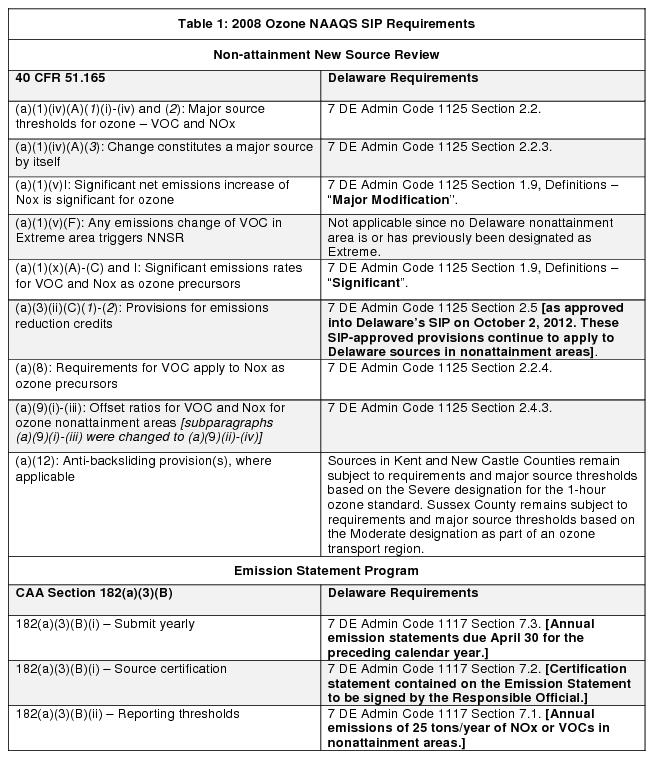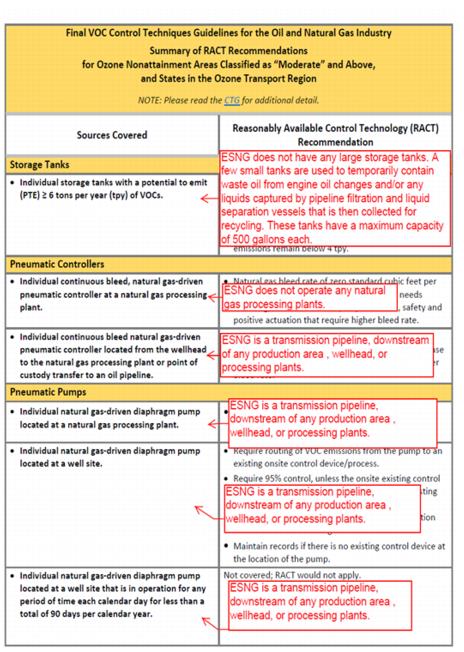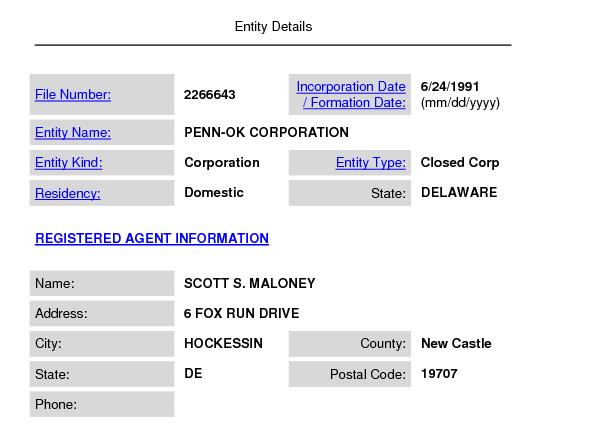DEPARTMENT OF NATURAL RESOURCES AND ENVIRONMENTAL CONTROL
Division of Air Quality
GENERAL NOTICE
Secretary's Order No.: 2018-A-0008
Date of Issuance: February 12, 2018
Effective Date of the Amendment: March 11, 2018
State Implementation Plan (SIP) Final Revisions
Under the authority vested in the Secretary of the Department of Natural Resources and Environmental Control ("Department" or "DNREC") pursuant to 7 Del.C. §§6006, 6010, the following findings of fact based on the record, reasons and conclusions are entered as an Order of the Secretary in the above-referenced regulatory proceeding.
Background, Procedural History and Findings of Fact
This Order relates to the proposed Revisions to the Delaware State Implementation Plan ("SIP"), to wit: (1) Certification of Delaware's Non-Attainment New Source Review and Emissions Statement Programs; and (2) Negative Declaration for Emissions Sources Specified in the Oil and Gas Control Techniques Guidelines ("CTG"). Delaware is required by Section 110 of the federal Clean Air Act to submit to the U.S. Environmental Protection Agency ("EPA") a SIP that provides for the implementation, maintenance, and enforcement of the national ambient air quality standards established by EPA. Delaware submitted its initial SIP to EPA in 1972. Delaware periodically submits revisions to the SIP as required by the Clean Air Act. The Clean Air Act requires that any proposed SIP revision be made available for public comment, and presented at a public hearing prior to submitting to EPA for adoption.
At the public hearing held on October 25, 2017, the Department presented two proposed SIP revisions for public review and comment:
1. Certification of Delaware's Non-attainment New Source Review and Emissions Statement Programs
The first SIP revision is a certification that two existing Delaware programs currently contained in the SIP meet all requirements of the 2008 ozone national ambient air quality standard. On February 3, 2017, the EPA issued a Findings of Failure to 15 states and the District of Columbia to submit certain required SIP elements for 2008 8-hour ozone standard non-attainment areas. According to the EPA's action, Delaware failed to certify its Non-attainment New Source Review Program ("Non-attainment NSR Program") for the Seaford and Philadelphia-Wilmington-Atlantic City non-attainment areas for the 2008 ozone standard. EPA previously approved Delaware's Non-attainment NSR Program SIP revision on February 28, 2013 that covered all 2008 ozone standard non-attainment areas. The Department finds and certifies that no changes are necessary to the Non-attainment NSR Program to comply with the 2008 ozone standard non-attainment NSR requirements.
The Department further determined Delaware's Emissions Statement program should also be certified for adequately addressing the 2008 ozone national ambient air quality standards. EPA approved Delaware's Emission Statement program on April 29, 1996. The approved emission statement rule, in force for the 1997 8-hour ozone standard and the 1-hour ozone standard, covers all portions of Delaware's non-attainment areas for the 2008 ozone standard, and is sufficient for purposes of the emissions statement requirements for the 2008 ozone standard.
2. Negative Declaration for Emission Sources in the Oil and Gas Control Techniques Guidelines ("CTG")
Section 184(b) of the federal Clean Air Act requires Delaware, as part of the Ozone Transport Region, to revise its SIP to implement Control Techniques Guidelines ("CTG") to control volatile organic compound emissions for all sources applicable to the CTG. Regarding the oil and gas CTG, no applicable sources exist in Delaware. Therefore, the Department is proposing a negative declaration for implementing the 2016 Oil and Gas CTG.
The Department has the statutory basis and legal authority to act with regard to the proposed SIP revisions as referenced above, pursuant to 7 Del.C. Chapter 60. The Department published the General Notice of the two proposed SIP revisions and the October 25, 2017 public hearing in the October 1, 2017 Delaware Register of Regulations. It should be noted that the EPA provided the Department with comments related to the proposed SIP revisions via email on September 22, 2017 and October 4, 2017. These comments were offered by EPA in order to provide additional clarity to the Department's proposed SIP revisions. The Department incorporated EPA's comments into its proposed SIP revisions prior to the public hearing. The revised proposed SIP revisions were then presented and fully vetted at the public hearing of October 25, 2017.
Members of the public attended that hearing, but no public comment was received by the Department with regard to this matter. It should also be noted that all proper notification and noticing requirements concerning this matter were met by the Department. Proper notice of the hearing was provided as required by law.
The Department's presiding hearing officer, Lisa A. Vest, prepared a Hearing Officer's Report dated January 26, 2018 ("Report"). The Report documents the proper completion of the required SIP revision process, establishes the record, and recommends the adoption of the revised proposed SIP revisions as attached to the Report as Appendix "A".
Reasons and Conclusions
Based on the record developed by the Department's experts and established by the Hearing Officer's Report, I find that the revised proposed Delaware SIP document is well-supported. Therefore, the recommendations of the Hearing Officer are hereby adopted, and I direct that the same be promulgated as final.
I find that the Department's experts in the Division of Air Quality fully developed the record to support adoption of the revised SIP document. The adoption of the revised SIP document will enable the Department to (1) provide certification that Delaware's Non-attainment New Source Review and Emissions Statement Programs meet all requirements of the 2008 ozone national ambient air quality standard; and (2) provide a negative declaration for emission sources specified in the oil and gas Control Techniques Guidelines issued by EPA.
The following reasons and conclusions are entered:
1. The Department has the statutory basis and legal authority to act with regard to its revised proposed SIP document, pursuant to 7 Del.C. Ch. 60;
2. The Department has jurisdiction under its statutory authority, pursuant to 7 Del.C. Ch. 60, to issue an Order adopting this revised proposed SIP document as final;
3. The Department provided adequate public notice of the revised proposed SIP document, and all proceedings associated with the same, in a manner required by the law and regulations. The Department provided the public with an adequate opportunity to comment on the revised proposed SIP document, including at the time of the public hearing held on October 25, 2017, and held the record open through close of business on November 10, 2017, consistent with 29 Del.C. §10118(a), in order to consider public comment on the same before making any final decision;
4. The Department's Hearing Officer's Report, including its established record and the aforementioned recommended revised proposed SIP document as set forth in Appendix "A", is hereby adopted to provide additional reasons and findings for this Order;
5. Promulgation of this revised proposed SIP document will enable the Department to (1) provide certification that Delaware's Non-attainment New Source Review and Emissions Statement Programs meet all requirements of the 2008 ozone national ambient air quality standard; and (2) provide a negative declaration for emission sources specified in the oil and gas Control Techniques Guidelines issued by EPA;
6. The Department's revised proposed SIP document, as published in the October 1, 2017 Delaware Register of Regulations, and as set forth in Appendix "A" as noted above, is adequately supported, is not arbitrary or capricious, and is consistent with the applicable laws and regulations. Consequently, it is approved as a final SIP document, which shall go into effect ten days after its publication in the next available issue of the Delaware Register of Regulations; and
7. The Department shall submit this Order approving as final the revised proposed Delaware SIP document to the Delaware Register of Regulations for publication in its next available issue, and provide such other notice as the law and regulation require and the Department determines is appropriate.
Shawn M. Garvin, Secretary
Proposal
Delaware State Implementation Plan Revision
Under the 2008 Ozone National Ambient Air Quality Standard
Certification of Delaware's Non-attainment New Source Review (NNSR) and Emissions Statement Programs
Submitted To
U.S. Environmental Protection Agency
Submitted By
Delaware Department of Natural Resources and Environmental Control
September 12, 2017
1. Introduction
On February 3, 2017 the EPA issued Findings of Failure to 15 states and the District of Columbia to submit certain required State Implementation Plan (SIP) elements for 2008 8-hour ozone standard nonattainment areas (82 FR 9158). According to EPA's action, Delaware failed to certify its Non-attainment New Source Review (NNSR) program for the Seaford, DE and Philadelphia-Wilmington-Atlantic City, PA-NJ-MD-DE nonattainment areas for the 2008 ozone National Ambient Air Quality Standards (NAAQS). [EPA The Department of Natural Resources and Environmental Control] further determined Delaware's Emissions Statement program [must should] also be certified for adequately addressing the 2008 ozone NAAQS.
2. Delaware Non-attainment Areas Designated Under the 2008 Ozone National Ambient Air Quality Standards (NAAQS)
EPA final designations under the 2008 ozone NAAQS for Delaware counties were finalized in April 2012. EPA included New Castle County in the marginal Philadelphia-Wilmington-Atlantic City, PA-NJ-MD-DE nonattainment area and established Sussex County as the stand-alone marginal Seaford nonattainment area.
On April 23, 2015, Delaware submitted the 2011 base year inventory of ozone precursors to EPA for New Castle and Sussex Counties. EPA issued a direct final rule approving Delaware's base year inventory on October 1, 2015. On April 12, 2015 Delaware submitted a RACT SIP revision certifying that Delaware, as part of the Ozone Transport Region, meets its obligation to establish RACT controls for VOC and NOx. On September 12, 2017, EPA published a proposal in the Federal Register (82 FR 42767) to approve Delaware's RACT SIP.
3. Certification of NNSR program
EPA previously approved a state-wide NNSR SIP revision on February 28, 2013 (78 FR 13496) which covered the Philadelphia-Wilmington-Atlantic City, PA-NJ-MD-DE and the Seaford, DE nonattainment areas for the 2008 ozone NAAQS. [Delaware has not subsequently amended the SIP-approved NNSR program. The NNSR program in Delaware’s approved SIP has not been amended.] Upon review of the [SIP-]approved NNSR program, Delaware finds and certify that no changes are necessary to comply with the 2008 ozone NAAQS NNSR requirements. The State of Delaware is certifying that its existing NNSR program is at least as stringent as the requirements at 40 CFR 51.165 for ozone and its precursors, as amended by the final rule titled Implementation of the 2008 National Ambient Air Quality Standard for Ozone: State Implementation Plan Requirements (80 FR 12264, March 6, 2015). [Note that the emission offset provisions of 7 DE Admin Code 1125 approved by EPA into Delaware's SIP on October 2, 2012 (77 FR 60053) continue to apply to DE sources in nonattainment areas. EPA did not approve into the SIP the provisions in 7 DE Admin Code 1125 that DE adopted on December 11, 2016. Thus the provisions in the approved DE SIP remain applicable requirements, and offsets can only be obtained from the expanded area identified in the December 11, 2016 adoption if the offsets also meet the provisions in the SIP (i.e., they are generated in an area of equal to or higher nonattainment classification, and they are shown to directly impact the nonattainment area where the offsets are being used.)] The requirements necessary to appropriately implement Delaware's NNSR program are included in Table 1.
4. Certification of Emission Statement Program
Section 182(a)(3)(B) of the Clean Air Act (CAA) requires states with ozone nonattainment areas to develop emission statement programs for VOC and NOx sources. The required state program and associated regulation defines how states obtain emissions data directly from facilities and report it to the EPA. EPA approved Delaware's Emission Statement program on April 29, 1996 (61 FR 7415). The approved emission statement rule, in force for the 1997 ozone NAAQS and the 1-hour ozone NAAQS, covers all portions of Delaware's nonattainment areas for the 2008 ozone NAAQS, and is sufficient for purposes of the emissions statement requirements for the 2008 ozone NAAQS. Delaware has reviewed its previously approved emission statement rule and is certifying to EPA that it meets the emission statement requirements for the 2008 ozone NAAQS. The requirements necessary to appropriately implement Delaware's Emission Statement program are included in Table 1.

Proposal
Delaware State Implementation Plan Revision
Under the 2008 Ozone National Ambient Air Quality Standard
Negative Declaration for Emission Sources Specified in Oil and Gas Industry Control Technique Guidelines
Submittal To
U.S. Environmental Protection Agency
Submitted By
Delaware Department of Natural Resources and Environmental Control
September 2017
1. Introduction
In October 2016, the US Environmental Protection Agency (EPA) issued the Control Techniques Guidelines (CTG) for the Oil and Natural Gas Industry (Reference 1, hereafter referred to as the 2016 Oil and Gas CTG). This document provides the states with ozone non-attainment areas and states in the Ozone Transport Region (OTR) a technical guideline for implementing controls to reduce volatile organic compound (VOC) emissions from leaks in the oil and natural gas production and processing industry.
Section 184 (b) of the Clean Air Act (CAA) requires states in the OTR, including Delaware, to revise their State Implementation Plans (SIP) to implement the CTG control techniques, as a Reasonably Available Control Technology (RACT) control measure, with respect to all covered sources of VOC emissions in the states. When a state confirms there are no applicable sources within its boundary, the revision to its SIP can be a negative declaration regarding the inapplicability of the CTG in the state, and therefore there is no need for implementing the CTG control (Reference 2).
This document is Delaware's negative declaration, as a SIP revision to its RACT SIP under the 2008 Ozone National Ambient Air Quality Standard (NAAQS) (Reference 3), regarding the 2016 Oil and Gas CTG. The agency with the direct responsibility for developing and submitting this SIP revision is Division of Air Quality (DAQ) within Delaware Department of Natural Resources and Environmental Control (the Department, or DNREC).
2. Determination on Non-Existence of Relevant Sources
The 2016 Oil and Gas CTG was developed to address VOC leaks in the oil and natural gas production and processing industry. Historically, and at present, Delaware has no facilities involved in industrial activities for oil and natural gas production and processing. Several facilities exist in Delaware for natural gas transmission and distribution only.
After issuing the 2016 Oil and Gas CTG, the EPA conducted an information collection request (ICR) of oil and gas facilities under the authority of section 114 of the Clean Air Act (CAA) to support the development of emission standards for existing oil and gas facilities under section 111 of the CAA. The EPA identified from its file three companies in Delaware that fell under the gas and oil segments: Penn-OK Corporation, Eastern Shore Natural Gas Company, and Delmarva Power & Lighting Company. The ICR was sent to all three companies and the Department in November 2016 and January 2017, respectively.
After receiving the ICR, the Department investigated the current status of the listed companies and their facilities, if any, in Delaware by either contacting the facilities or reviewing facility permit and emission files. The investigation has demonstrated the following.
(1) Penn-OK Corporation, identified in the ICR Part 1, was not recorded in Delaware's emission inventory. A search from Delaware Division of Corporations (DDC) found that this company was incorporated in Delaware in 1991 and closed on a later date (closing date unidentified, see Attachment 1). As shown in the DDC record, its location identified in the ICR (6 Fox Run Dr., Hockessin, DE 19707) was its registration agent's address. A further search in Google Map indicated that this address represented a single family house in a residential area.
(2) Eastern Shore Natural Gas Company, identified in the ICR Part 2, is not an oil or natural gas production and processing facility, but has two boosting stations (Permits#: APC-1996/0895-Operation, and APC-2005/0031-Construction/Operation) as part of the local natural gas transmission and distribution system. Upon request, the company provided the Department its status regarding the 2016 Oil and Gas CTG RACT summary sheet (see Attachment 2).
(3) Delmarva Power & Light Company in Wilmington, identified in the ICR Part 2, does not have any oil or natural gas production and processing facilities in Delaware. As shown in its permit file (Permit#: APC-2009/0002-Construction/Operation), the company has a natural gas distribution facility which stores liquefied natural gas and vaporizes/distributes it to the distributing system on peak-demand days.
In addition, the Department reviewed its air permits, emissions inventory files and Delaware business listings, and found no other facilities in Delaware that are currently involved in oil and gas production and processing activities.
3. Negative Declaration
Delaware hereby declares that it does not have any facility that has sources being covered by the 2016 Oil and Gas CTG. Therefore, a new Oil and Gas RACT rule will not be developed and incorporated into Delaware's RACT SIP under the 2008 ozone NAAQS. Delaware's RACT SIP under the 2008 ozone NAAQS (Reference 3) is still valid and sufficient.
References
1. Control Techniques Guidelines for the Oil and Natural Gas Industry, EPA-453/B-16-001, US Environmental Protection Agency, October 2016. https://www.epa.gov/sites/production/files/2016-10/documents/2016-ctg-oil-and-gas.pdf
2. The 2016 Oil and Gas CTG link:
3. Delaware Reasonably Available Control Technology (RACT) State Implementation Plan (SIP) under the 2008 Ozone National Ambient Air Quality Standard (NAAQS), submittal to EPA by Delaware Department of Natural Resources and Environmental Control, effective August 2014.
Attachment 1
Status of Peen-OK Corporation
Search result from Del. Division of Corporation search: The facility closed.
Attachment 2
Facility information provided by Eastern Shore Natural Gas (ESNG) Company upon the Department request.










